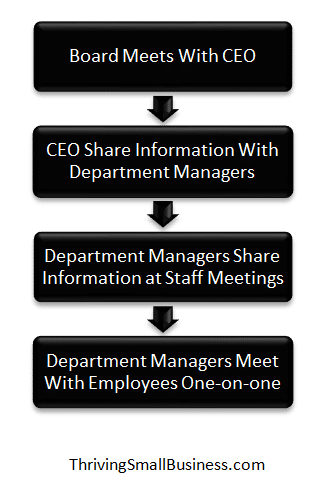Its About The Process – Not The People
Estimated reading time: 5 minutes
Employees go to work every day with the intention of doing a good job. Unfortunately, internal processes impact their ability to do just that!
Organizations are responsible for creating systems and infrastructures that support employee performance.
This is done by thinking through steps in a process, documenting those steps, and creating policies that ensure those process steps are followed – by everyone.
A speaker at an Institute for Healthcare Improvement (IHI) Conference once said:
“every system is perfectly designed to
achieve exactly the results it gets”.
This is so simple – yet so true.
Good employees, who are forced to work with bad internal systems, often fail.
Consequently, improving the system or process that employees work in will ultimately improve their performance.
Bad Process Example
Here is an example of what I mean by a bad process. In this example, we are talking about communications processes. Yes, effective communication requires a structured process.
I recently met with a manager who expressed how she had done a poor job communicating with her employees.
She explained that she had dropped the ball when it came to communicating and interacting with her staff. This error resulted in a key employee resigning.
We spoke for a while, and I explained to her that failing to communicate should be recognized as a process issue.
And, if she could see it from that perspective, then any improvement would focus on the process instead of her.
The goal was to take her out of the equation and focus on creating a process that would support good communication.
I asked the manager if she had a communication “process.”
In other words, did she have a predetermined day or time that she communicated with her employees, or did she communicate only when issues arose, or when she casually thought about it?

She explained that there was no communication process and she was so busy she just didn’t think about it much.
The lightbulb was beginning to go off as she recognized her role in the process.
She shared that the more employees pressured her for interaction, communication, or information, the more she retreated. This retreat was because she was simply overwhelmed.
Eliminate Obstacles To Communication
We then talked about establishing some basic processes that would help eliminate the obstacles to communicating.
Some would label her as a bad manager.
However, I would like to think she simply needs help in improving her management processes.
In the example above, the employee resigned because she didn’t feel like she had ample opportunity to meet with their manager to discuss department-related issues.
The employee felt like she had a perspective that could improve operational efficiencies in the department that were not being heard.
The breakdown in communication between the manager and the employee caused frustration for the employee. This frustration, over time, turned into discouragement and, ultimately, a decision to resign.
It is the Manager’s Job to Meet With Employees
A manager is responsible for employee performance. And the only way a manager can tell how an employee is doing is by monitoring their goals, observing how they work, and talking to them.
Managers should meet with employees regularly and provide the opportunity for staff to ask questions and share information.
For instance, when meeting with an employee, a good conversation starter is simply asking, how can I help you?
When a manager offers to help an employee, it opens the door for conversations about the work process, barriers to getting the job done, or employee conflict.
It Is the Manager’s Job to Communicate Information
Employees need lots of information to do their job. Some information is tied to how the business is operating, and some information impacts an employee’s job duties.
Managers need to be aware of this dynamic and share information as they receive it.
For instance, if the business is changing to new software, employees need to be aware so they can prepare for the transition.
Communication processes need to be structured to ensure there is consistency in sharing helpful information with employees.
Whether it is a weekly staff meeting, quarterly state-of-the-organization meeting, or monthly one-on-one meetings, providing a structured, predictable process helps employees know that their issues will be heard, the information will be shared, and they will be provided the opportunity to ask questions.
Had the manager created a structured, predictable communication process, the unresolved issues might have been avoided.
And if the organization had formal communication processes that managers were held accountable for, the manager would have been better structured to communicate.
Create a Communication Process
I am familiar with a very structured communication model.
- The board meets with the CEO,
- The CEO then shares information with managers,
- Managers are required to meet with staff to ensure information flows throughout the organization.
Example Business Communication Process

Managers are also required to meet with their employees – at least monthly, and performance appraisals are done at least once a year.
A structured model like this works well because it forces managers to communicate with employees.
Structured Processes Help Employees Do a Good Job
Structured management processes help managers to do a good job.
Whether is it is a communication process, performance management process, or a simple purchasing process, every organization needs structured processes to ensure there is predictability in all internal systems.
This focus on improving the process translates into an improved work environment for the employees who use them.






